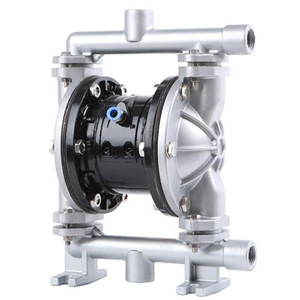How to Select Diaphragm Materials for Diaphragm Pumps?
Diaphragm pumps are widely used in some industries and are almost indispensable. The diaphragm pump sucks and discharges gas by means of the reciprocating motion of the diaphragm in the pump body, so the diaphragm is a very important part of the pump body, and its performance has a great influence on the pump. The life of the diaphragm is embodied in several aspects, bending Life, corrosion resistance, high and low temperature performance, so the range of diaphragm materials to meet the above requirements is greatly reduced. So far, the most widely used and mature rubbers in the diaphragm industry are EPDM, PTFE, FKM, NBR, etc. However, how to select diaphragm materials for diaphragm pumps?

EPDM
EPDM rubber is a copolymer of ethylene, propylene and a small amount of non-conjugated diene. The main chain is composed of chemically stable saturated hydrocarbons. It is a common rubber with the lightest raw rubber density.
Performance characteristics
- Anti-aging properties: Ozone resistance, UV resistance, and other aging properties, when copolymerized with other unsaturated dienes, the oxidation resistance and anti-aging properties are significantly improved.
- Chemical resistance: good resistance to weak acid, alkali, alcohol and ketone; excellent resistance to water and water vapor, radiation resistance.
- Insulation: high volume resistivity, breakdown voltage of 30-40MV/m, can effectively reduce the influence of static electricity caused by friction.
- Applicable temperature: The minimum operating temperature is -40~-60℃, and it can be used for a long time under the condition of 130℃. (The diaphragm material is applicable at this temperature, which does not mean that the pump can also be used at this temperature. The operating temperature of the pump is comprehensively affected by the motor, diaphragm, cavity material and other accessories).
- Application field: It is widely used in automobile parts, building materials, seals and other fields.
PTFE (Polytetrafluoroethylene)
PTFE, also known as "Teflon", is a polymer compound formed by the polymerization of tetrafluoroethylene. It is one of the best corrosion-resistant materials in today's society.
Performance characteristics
- Anti-aging properties: Non-moisture, non-flammable, extremely stable to oxygen and ultraviolet rays, and has excellent weather resistance.
- Chemical corrosion resistance: It can resist aqua regia and most organic solvents. Even if it is boiled in aqua regia, its quality and performance are unchanged. The corrosion resistance is extremely excellent, but it is not resistant to radiation. It is easy to cause degradation after radiation. The electrical properties and mechanical properties are significantly reduced, so the diaphragm used in the exhaust gas sampling pump of the nuclear power plant is mainly made of EPDM material.
- Insulation: The breakdown voltage, volume resistivity, and arc resistance are all high, making it an ideal insulating material; Applicable temperature: It maintains excellent mechanical properties in a wide temperature range of -196 to 260 °C, and does not work at low temperatures. become brittle and still retain very good flexibility.
- Volume deformation rate: It is a typical soft and weak polymer, the mutual attraction between macromolecules is small, and the stiffness, hardness and strength are small, and it will deform under long-term stress.
- Application field: In the petrochemical and metallurgical industry, pipelines, pumps, valves and other equipment that need anti-corrosion are widely used. As coating and impregnating materials, they are widely used in textile, medical, chemical, electrical and other fields.
Note: According to the list of carcinogens of the International Agency for research on cancer of the World Health Organization, polytetrafluoroethylene is a class 3 carcinogen, that is, it is not clear that its carcinogenic effect on human beings. It is recommended to take protective measures when using or contacting such materials.
FKM (Fluorine rubber)
Fluorine rubber is polymerized by fluorine atoms contained in the carbon bond of the main chain or side chain to form a polymer material. There are many derivatives of fluorine rubber, and the performance varies greatly. This kind of material can be seen in all walks of life.
Performance characteristics
- Anti-aging characteristics: excellent weather resistance, can also be used for a long time in an environment with high ozone concentration.
- Chemical resistance: relatively stable chemical properties, resistant to most organic and inorganic solvents, and most petroleum-based oils, but not resistant to low-molecular-weight ketones, ethers, esters, ammonia, etc. Not resistant to radiation, easy to crack after irradiation, and the structural strength has a relatively obvious decline.
- Insulation: low hygroscopicity, good insulation.
- Applicable temperature: resistant to a certain high temperature, can still maintain a high mechanical strength at 200 ℃, but there is a certain volume deformation.
- Application field: As a seal in the chemical industry, it can be used to seal various organic solvents, as an insulating material for wires and cables in the petrochemical industry, with high oil resistance and wear resistance, and is also widely used in the automotive engine industry.

